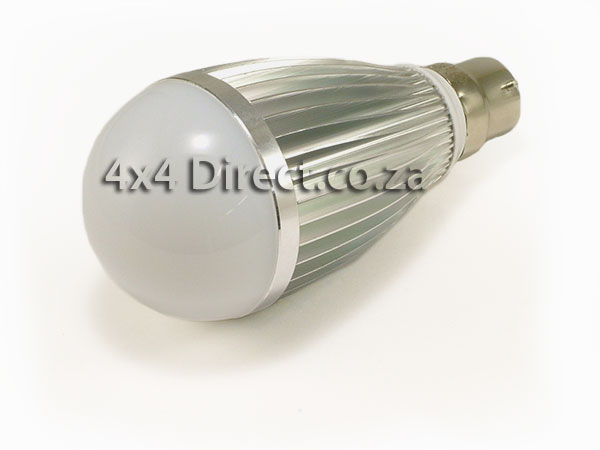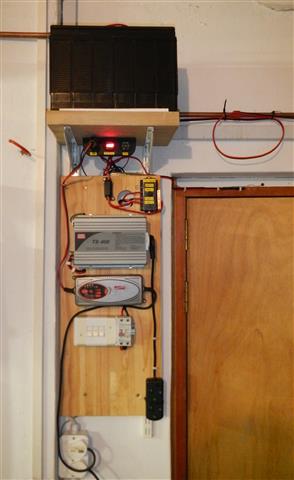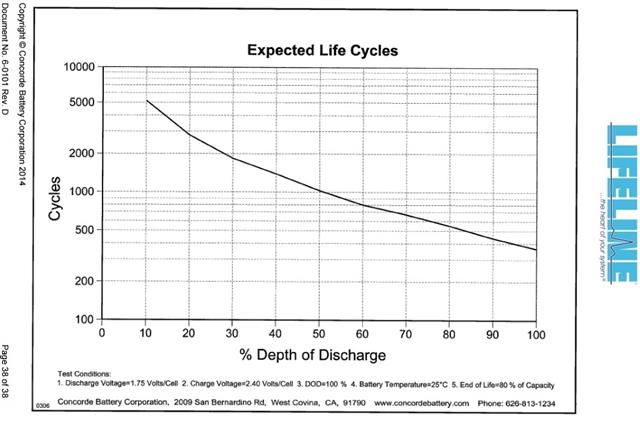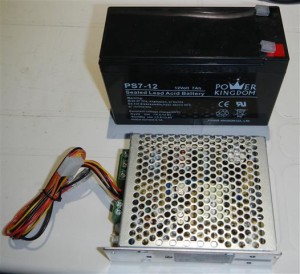Powering your 12V lights in your Home

This is an excerpt from ChrisF’s post on the Hilux forum:
Powering your 12V lights
not sure if this should be a separate thread, or if we should rather keep all the info together …..
long long ago in an era before candles, in fact in a time before a uniquely african thing called “load shedding” we had the option of using transformers to power 12V light systems. Yes, many downlighters have been 12V for years already, but powered from 220V.
Now to power the 12V lights when eskom takes time off to count their profits …..
BATTERIES.
Never have there been a topic more hotly debated than what battery to use and how to use it.
There are just so many things that determine what will work for YOU :
Cost
Space
your system
etc etc
The cost effective load-shed-buster system may well look like this –
This specific charger system makes it a VERY versatile solution !! You connect 220V to the charger, then connect it to the battery. But you connect the light (load) directly to the charger unit. When 220V is supplied to the unit, the light is powered from the 220V source and the battery remains fully charged. When eskom takes a brake the unit automatically switch over to the battery and your light wont even know the power went off.
The other approach may look something like this –

100Ah battery with a 220V and/or PV charger system.
There are a number of technical bits to consider when selecting your components :
– total light circuit power draw
– battery capacity to match the former
– 220V charger
– pv charger and panel size
Total light circuit power draw –
WHAT do you want to do with your 12V lights ?????
A couple of LED strips and one or two downlighters purely to provide emergency lighting ?
OR do you want to switch over a few rooms completely to 12V lighting ?
here are a few numbers from our system :
Kitchen – 1,2m of 14W/m high bright LED strip. This draws 1,4A at 12V. During winter this light is used roughly 3 hours at night and another 1 hour in the morning. The current draw is thus : (3+1)x1,4 = 5,6A.h
I live in my braai room, aka man cave. The 12V lights here draws another 5A.h per winter night
The bedrooms draw maybe another 1Ah per night.
Thus our system draws maybe 12Ah on a long winters night.
NOTE – this is for a household with TWO people. Add 1 or 2 kids and the power draw WILL drastically increase.
Battery capacity required ??
For the purpose of this thread I will be using conventional wisdom. Graphs from the following website – http://www.lifelinebatteries.com/manual.pdf
Depth of discharge vs battery life –

Basically this graph states the following :
– if you use 50% of the capacity each night you may reasonably expect to get 1000 cycles out of this AGM battery (this would be between 500 and 1000 cycles for a deep cycle battery)
– if you only draw 10% of the battery capacity per night you could reasonably expect to get 5 000 cycles from it, or more that 10 years !
CONLUSION – your battery capacity SHOULD be more than DOUBLE the nightly current draw. Ideally 3 to 4 times the nightly draw. Better still if the battery capacity is such that you only draw 10% per night.
Application –
IF you use the 7A.h battery – you could expect to use about 3A.h per load shed and not damage the battery. That is a constant 1,5A draw, or about 18W. This could be 6 downlighters, or about 1,5m of 14W/m LED strip (remember you CAN use a number of small strips to total up to this 1,5m). Make no mistake, that IS a lot of light for backup purposes, though you wont be reading under these lights.
With a typical 100A.h deep cycle battery you could use 50Ah over a period of about 5 hours, thus a 10A draw. To put this in perspective. Hoppy’s 24 off 3W LED lights only draw 6A.
PS – once you have a deep cycle battery you will add an inverter for the tv/computer. THIS accounts for about 40A.h during a load shed !!!! Thus on load shed days use the lights sparingly or you will drastically reduce the battery life !! And THIS is why Pieter is trying to source a larger 12V battery.
One could make a bank of batteries, but KNOW that this comes with various other issues, ie keeping the batteries balanced. Buying a single large battery surely has many benefits !!
When speaking to an industry specialist he stressed the importance of the QUALITY of the charger as very important in ensuring long life for the battery.
Here we are talking of the likes of the Benton BX range. The BX2 has a maximum charge rate of 7A. This is less than 0,1C, ie less than 10% of the battery capacity (for a 100Ah battery 0,1C will be 10A). Even with a 50% discharge after a load shed this low charge rate will fully recharge the battery long before the next loadshed on the next day. Thus NO reason to even consider any of the fast chargers. And we know that a slow charge IS better for a battery, even if some suppliers now claim their units can accept a higher charge rate. We simply dont need the high speed charge in this type of application, thus rather protect your investment.
If you are going the route of the 7Ah battery, please do get one of these small power supplies suited to the smaller battery.
PV charger and panel size –
we have a range of PV chargers to choose from. Typically you can choose between PWM or MPPT.
PWM – Pulse Width Modulating – basically this unit switches the PV panel ON and let the battery see the full panel voltage, but as the panel voltage is too high it switches the panel off again, and on and off and on and off ….. The width of these pulses determine how much power flows from the panel to the battery. You can buy these for under R300. Unfortunately this cheap charger stops the charge rate at 13,9V, thus it wont ever charge the battery fully. For a full charge the charge volts needs to go up to about 14,5V for a short period.
MPPT – Maximum Power Point Tracking – looking at the V-A curve of a PV panel one can see there is a specific voltage at which the panel delivers maximum current. Bear in mind the maximum current varies throughout the day in accordance with the position of the sun. Thus the maximum power point is an ever moving target. The MPPT solar regular constantly monitors the maximum power point of the panel, and adjusts the charge current accordingly. For good measure it also measures the state of charge of the battery and further adjusts the volts and amps to the battery to ensure the best possible charge rate for both the available power and the state of charge.
understandably the MPPT units are not exactly cheap …
PV panel size – play on sites such as these http://re.jrc.ec.europa.eu/pvgis/ and you will soon realise the massive differences of the available power between Summer and Winter !! Summer time I can get near 6 hours worth of maximum power from the PV panel, my flat mounted PV panel hardly gets 4 hours worth of power in winter – IF and only if there is zero cloud cover ….
Let’s say the charge voltage is 14V, then the maximum charge current from a 100W panel is 7A.
Let’s consider a clear sunny winter day – now if only we had these in the Cape – then I could get 7 x 4 = 28A.h maximum from a 100W solar panel. Now allow for the fact that my panel is mounted flat, and I would be lucky to see 15A.h during a clear sunny day in mid winter !! Dark cloud cover and I get 0A.h ! Light cloud cover would still deliver a bit of power … But this applies to the worst two months of the year only. Summer I could easily get 7 x 6 = 42A.h …..
Way more than I need for the 12V lights.
BUT, not enough to fully charge the battery after a load shed !!!!
For now I monitor my battery voltage and use the 220V charger to supplement the charge during extended rain days. I also use the 220V charger after a load shed. Still considering long term solutions\options ….
Well worth talking about the angle of the panel – IF you mounted your pv panel at an angle of about 45 degrees and facing North you would get significantly better charge rates than I am getting now !! But I only have a flat roof near my installation and I hate these mounting frames with a passion.
